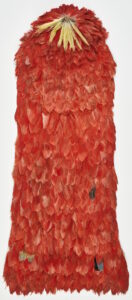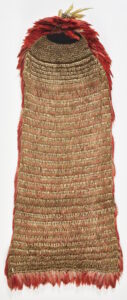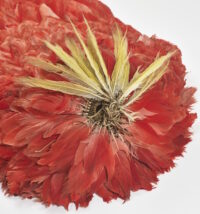 The National Museum of Denmark has donated its most exceptional 17th century Brazilian feather cape to the new National Museum of Brazil to help rebuild the museum’s patrimony after its entire ethnographic collection of 20 million irreplaceable artifacts was destroyed in a fire in 2018. Interestingly, the iconic scarlet ibis feather cape was not among them, as the few surviving examples known were all in European museums.
The National Museum of Denmark has donated its most exceptional 17th century Brazilian feather cape to the new National Museum of Brazil to help rebuild the museum’s patrimony after its entire ethnographic collection of 20 million irreplaceable artifacts was destroyed in a fire in 2018. Interestingly, the iconic scarlet ibis feather cape was not among them, as the few surviving examples known were all in European museums.
Made by hand-tying scarlet ibis and macaw feathers to a woven cotton net, the cape dates to the early 1600s and was crafted by the Tupinambá people of Brazil. The Tupinambá were the first indigenous people the Portuguese encountered when they reached eastern Brazil in 1500. European chroniclers record that the Tupinambá were adept feather workers and used local bird feathers in jewelry, sashes, headbands, cloaks, even as tattoo needles. Used in important rituals and ceremonies, the scarlet ibis cloaks were revered for their beauty and religious significance.
 The Tupinambá were described as taking painstaking care of their feathered items, handling them with kid gloves to prevent deterioration. They were not so gingerly handled by the Portuguese, Spanish and by the functionaries of the Dutch West India Company which occupied parts of northeast Brazil between 1624 and 1654. The striking feathered cloaks made their way into the collections of the European monarchs and other wealthy collectors, but few were able to survive the centuries.
The Tupinambá were described as taking painstaking care of their feathered items, handling them with kid gloves to prevent deterioration. They were not so gingerly handled by the Portuguese, Spanish and by the functionaries of the Dutch West India Company which occupied parts of northeast Brazil between 1624 and 1654. The striking feathered cloaks made their way into the collections of the European monarchs and other wealthy collectors, but few were able to survive the centuries.
Today only 11 Tupinambá feather capes are known to survive, several of which are also owned by the National Museum of Denmark. The recently-donated cloak is the best preserved of all of them. Compare it to the cloak at the Pinacoteca Ambrosiana in Milan to see how much denser the feather coverage is and how pristine each individual feather still looks. It even retains the small hood made of yellow macaw feathers, long since lost from the Ambrosiana example.
 The Tupinambá population plummeted after their encounter with European pathogens, but the tradition of feather work never stopped. Today there are around 4,600 recognized Tupinambá in Brazil and their leaders have been working with officials from the National Museum in Rio to negotiate the return of the sacred feather cape from Copenhagen.
The Tupinambá population plummeted after their encounter with European pathogens, but the tradition of feather work never stopped. Today there are around 4,600 recognized Tupinambá in Brazil and their leaders have been working with officials from the National Museum in Rio to negotiate the return of the sacred feather cape from Copenhagen.
Upon receiving the letter from Dr. Rane Willerslev, Director of the National Museum of Denmark, chief Tupinambá Babau said: “For us, the donation of the Tupinambá mantle means the return of an ancestor! It is also the return of hope that never dies: a concrete answer for those who believe in the strength of their people and continue to fight for their culture, secrets and religion. We continue to create other mantles. But now, by a generous donation, our greatest relic will return to Brazil! The bird that symbolizes this mantle, the ibis, which no longer exists in our region, is born and grows gray. When eating crabs, their feathers turn red. It is a sign of transformation that occurs in everything, human beings and their culture. Many thanks to the National Museum of Brazil and Denmark for allowing us to hear the sacred words of our ancestors again. The Cloak is back!”
The Museu Nacional is in the process of rebuilding its ethnographic archives and physical collections in close collaboration with the country’s indigenous peoples and museums outside Brazil. The National Museum of Denmark and a number of other European museums are already supporting the reconstruction by creating digital catalogues that will make Brazilian artefacts and archive material located in European museums available. […]
“The feather cape has had a prominent place in our collection, but it has greater significance for the Brazilian population as a cultural symbol, as a material heritage of the Tupinambá and as evidence of Brazilian-European historical, colonial encounters. In Brazil, it will be available to the indigenous peoples who have a strong historical and cultural connection to it,” says Christian Sune Pedersen, head of research.
The cape will remain in Copenhagen long enough to be photographed in high resolution and analyzed to determine its age, origin and exact composition. Meanwhile, the National Museum of Brazil will focus on creating an ideal setting for the long-term conservation and display of the cape.